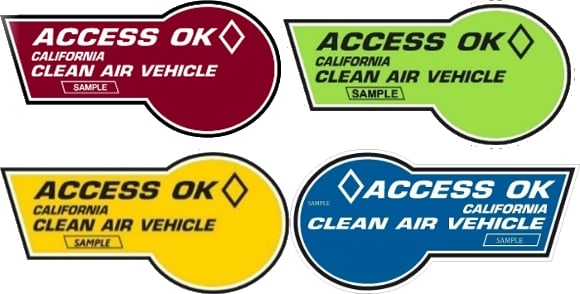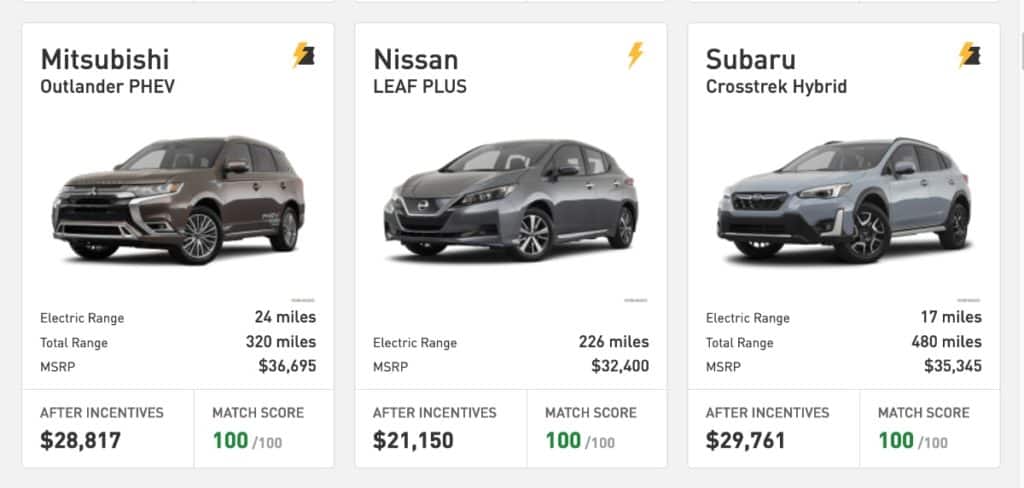
You might have noticed an increased number of electric vehicles on the road and wondered whether it’s a good time to buy or lease one yourself. In addition to the environmental benefits of an electric vehicle and the fuel savings at the pump, there are also numerous federal and state incentive programs to help with the cost of buying or leasing the vehicle itself.
Federal Programs
- Qualified Plug-In Electric Drive Motor Vehicle Credit: For qualified vehicles purchased in or after 2010, individuals and businesses alike may be eligible for a tax credit of up to $7500. Check out the website for qualified vehicles and to find the appropriate IRS forms.
California Programs
- California Clean Air Decals: These decals give California residents exemption from HOV/HOT lane restrictions. Valid decals come in four colors:
- maroon (exp. 9/30/25), green (exp. 9/30/25), yellow (exp. 9/30/25), blue (exp. 1/1/25)

- Clean Vehicle Rebate Project (CVRP): For individuals or business owners purchasing or leasing electric vehicles in the state of California, CVRP is a certified rebate program which offers rebates from $1,000 to $7,500 for the purchase or lease of new, eligible zero-emission vehicles, including electric, plug-in hybrid electric and fuel cell vehicles.
- Pre-owned Electric Vehicle Rebate Program: When purchasing or leasing a pre-owned electric vehicle, Pacific Gas and Electric Company (PG&E) customers may be eligible for up to $4,000 in rebates.
- California Hybrid and Zero-Emission Truck and Bus Voucher Incentive Project (HVIP): This program is designed to offset the costs of eligible hybrid and battery-electric medium and heavy duty vehicles through purchase vouchers at qualified dealerships. Generally intended for fleet vehicles.
- Empower EV Program (starts 2023): PG&E will offer incentives of up to $2,500 per income-eligible single family household to help cover the cost of purchasing and installing EV charging equipment.
- MCEv Charging for Your Workplace or Multifamily Property: This program offers rebates of $3,000 per Level 2 charging port and $750 per Level 1 charging port for charging hardware and installation costs for worksites and multifamily properties located in MCE’s Service Area.
- Vehicle Retirement Customer Assistance Program: This program offers eligible consumers an incentive to retire their operational vehicle. Consumers meeting the income eligibility requirement may receive $1,500 for each vehicle retired. All other vehicle owners may receive $1,000 to retire their vehicle.
- Clean Vehicle Assistance Program – Beneficial State Foundation: Beneficial State bank has committed to providing loans at an 8% interest rate or lower to participants of the Clean Vehicle Assistance Program.
- Clean Air Vehicle Discount: If you have a qualifying clean air vehicle, you are eligible to drive in the carpool lane on state-owned bridges (except for the Golden Gate Bridge) and in Bay Area Express Lanes as a single occupant and receive applicable toll discounts.
- Electric Vehicle Rate Plans: PG&E offers two rate plans which can help lower energy costs for residential customers with an EV. EV2A combines your vehicle’s electricity costs with those of your residence. EV-B involves the installation of another meter, which separates your electric vehicle’s costs from those of your home’s electricity usage.
- Property Assessed Clean Energy (PACE) Loss Reserve Program: Property owners in a PACE-designated area can use PACE financing for clean energy home improvements, including electric vehicle charging infrastructure, without a down payment and repayment included in their property tax bills.
And, if you are worried about running out of charge while driving a plug-in electric vehicle in Contra Costa County, there are plenty of electric vehicle charging stations available for public use.
Electric Vehicle Savings Calculator
With PG&E’s EV Savings Calculator, find out instantly how much you’d save on the purchase of a specific make and model of EV. Use the calculator to search and compare EVs, and discover thousands of dollars of savings through incentives, rebates and more.

